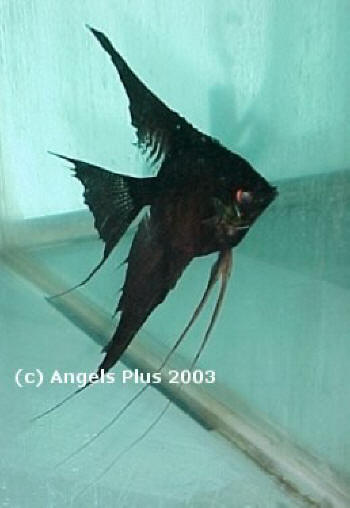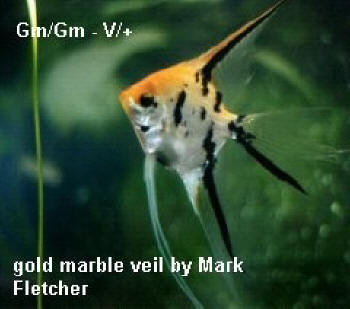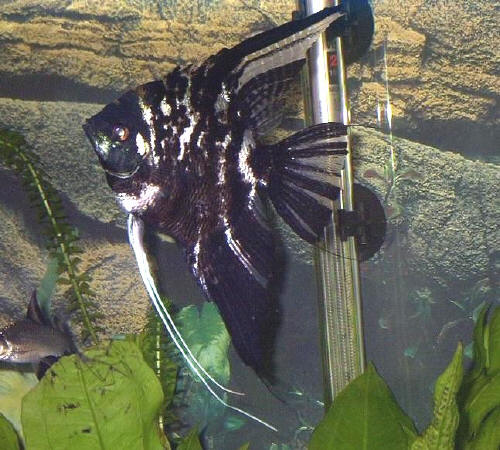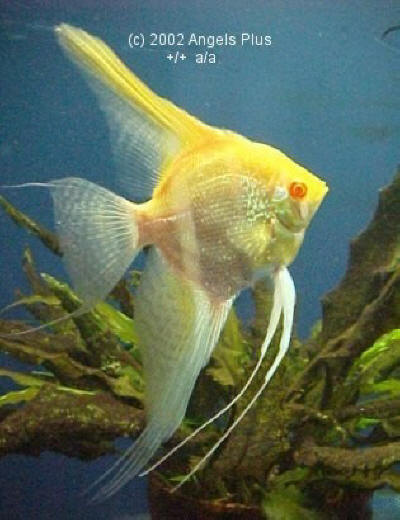|
|
Next
| Top
| Table of
Contents |
Phenotypes Library
Page |
HomePage
|
|
Table of
Contents
|
The following
pages will contain a slideshow of the phenotype photos. At
the top will be thumbnails - click on the small photo and
the large picture below will become that slide.
The slideshow is in java and the transition time varies with your hardware
and internet connection.
You may use the bookmarks ("next" "top" "menu"
"contents")
to go to a specific section in the series.
If you have any
problems with this presentation, please contact
the
TAS Web Committee.
|
|
|
Back |
Next
| Top
| Table of
Contents |
Phenotypes Library
Page |
HomePage
|
|
Angelfish Phenotypes
Viewing the color and
pattern modifications caused by the known angelfish mutations may help
with understanding the effects of these gene on other phenotypes.
The following color locus pages will highlight the most common angelfish
color forms and their common variants .
Phenotype = the
physical appearance of a trait
Genotype = the
written expression of the genetic makeup of the trait
Locus = the
specific location of a gene on the chromosome
“The angelfish's chromosomes (containing the genetic material) are in
pairs, one chromosome of each pair having come from each parent. Each gene
occurs at a specific location, called locus
(plural, loci), on the chromosome. Variations of a gene are called alleles. Only one
allele occurs at a locus; another allele of that gene can occur at the
same locus on another chromosome.” by Dr. Joanne Norton FAMA: July 1982,
Vol. 5, #7
reference materials:
Dr. Joanne Norton’s Articles
on Angelfish Genetics.
|
| Back |
Next
| Top
| Table of
Contents |
Phenotypes Library
Page |
HomePage
|
|
Angelfish Genetic Notations
A. Notation to
be used for accepted genes:
1. The letter designation of a gene name shall be
its first letter unless that letter is already taken in which case the
first two letters of the gene name shall be used.
2. The first letter will be uppercase if the gene is
dominant to wild-type. The first letter will be lowercase if the gene is
recessive to wild-type.
3. The second letter will always be lowercase.
4. If the first two letters are already used for an
existing gene notation, then the next available consonant in the gene
name will be used for the second letter.
5. The first letters of each word will be used for genes with more
than one word attached to them.
6. Wild-type will be designated by (+).
7. The preferred written format will be to separate alleles with a
(/). ex. for Hybrid Black D/g; for Smokey Sm/+. Fish that are
dual-hybrids, tri-hybrids, etc. will have loci separated with a (-).
ex. for Zebra Lace Z/+ - D/+ or Z/Z - D/+; for Half-black Zebra Lace
h/h - Z/+ - D/+
B. Genes accepted as being proven through Dr.
Norton's work and their letter designations:
|
1. Dark |
D |
partially dominant
|
Dark locus |
|
2. Marble |
M |
partially dominant
|
Dark locus |
|
3. Zebra |
Z |
partially dominant
|
Stripeless
locus |
|
4. Gold |
g |
recessive characteristic |
Dark locus |
|
5. Stripeless |
S |
partially dominant
|
Stripeless
locus |
|
6. Smokey |
Sm |
partially dominant
|
Smokey
locus |
|
7. Half-black |
h |
recessive characteristic |
Halfblack locus |
|
8. Gold marble |
Gm |
partially dominant
|
Dark locus |
|
9. Pearl |
p |
recessive characteristic |
Pearl
locus |
|
10. Streaked |
St |
partially dominant
|
Streaked locus |
|
11. Veil |
V |
partially dominant
|
Veil locus |
|
12. Albino |
a |
recessive characteristic |
Albino locus |
|
|
Back |
Next
| Top
| Table of
Contents |
Phenotypes Library
Page |
HomePage
|
|
Wild Type, Silver +/+
First the wild form, Silver (+/+)
Silvers
The silver (genetic notation +/+) or wild type is the
basis for all of the domestic mutations that have
occurred. Wild type should not be confused with
wild caught which are angels actually caught in the
wild. Our domestic silvers most closely resemble
wild angels.
A silver angel can be described as silver gray in color
with 3 vertical stripes including the stripe over the
eye. Silvers are considered among the hardiest and
easiest to raise and breed. Good quality silvers
should show dark complete stripes. The stripes may
fade when the fish is stressed. Silvers raised in
less than optimal conditions may show lighter colored
stripes that may not be complete. Silvers
raised in continuous light will not show any stripes at
all, except for perhaps all or part of the eye stripe.
Several recessive genes can be
hidden in single doses and not change the appearance of
a silver angel. These are gold (+/g), albino (+/a),
halfblack (+/h), and pearlscale (p/+).
Streaked can be hidden in both single (St/+) and double
doses (St/St) as it only expresses on dark fish.
.
|
|
Back |
Next | Top
| Table of
Contents |
Phenotypes Library Page |
HomePage |
|
The Dark Locus
Dark
The dark locus can contain the wild
type genes or any of four color mutations. Dark,
gold, gold marble or marble.
D/+ When dark is added to a
silver angel a black lace is produced. This was one
of the first mutations reported. The stripes are the
same but the fish takes on a dark gray brown background.
The markings in the fins also become more pronounced.
.
A beautiful standard finned black lace

A beautiful standard finned black lace
D/D Dark in double dose produces a black angel often
referred to as a double dark black to distinguish it from
the hybrid blacks. Double dark blacks are often very
black and only under strong lighting can the underlying
stripes usually be seen. They are slow growing in
comparison to hybrid blacks (D/g, D/Gm, and D/M) so are
often more difficult to find commercially.
Double dark black veil combtail

Gold
g/+ Gold in single dose produces no changes on the
silver angel. In double dose it produces the gold
angel (g/g). A fish devoid of stripes which can vary
in color from light silver yellow, to dark yellow, even
showing some orange especially when mature. Very young
golds can sometimes show the underlying stripes as lighter
vertical lines on their body.
Female gold veil with over 2000 eggs

Gold Marble
Gm/+ The gold marble gene in single dose will produce a
silver angel with random dark spots. The silver angel’s
stripes will be present. This is typically referred to as a
silver gold marble or barred gold marble. Interestingly the
stripes will fade with conditions and mood while the gold
marble spotting will not fade.
Barred gold marble showing quite a bit of patterning This one just shows a few gold marble markings.

Barred gold marble showing quite a bit of patterning
Gm/Gm The gold marble gene in double dose produces a gold
marble angel. Similar in base color to the gold angel but
with the addition of random black spots like the silver gold
marble.
The amount of gold marble pattern can vary between lines. Double dose gold marble will always show more pattern than single dose gold marble within t Double dose gold marble from Dr Norton's article.

The amount of gold marble pattern can vary between lines. Double dose gold marble will always show more pattern than single dose gold marble within t
Marble
The
marble gene causes a marbled brown to black pattern on a
gray to white background.
M/+ The
single dose marble angel has a brown pattern to it with less
contrast to the base color as opposed to marble in double
dose or when combined with gold or gold marble. The stripes
are pretty well hidden in M/+ but sometimes they can be seen
through the marble pattern.
A nice standard finned marble It would help to clean the glass first :) Some lines of marble show a very brown pattern when M/+. This line was called calico marble.

A nice standard finned marble
M/M In
double dose there is more marble pattern and the contrast
between the pattern and background is greater. Whereas
M/+ often will display a red iris as it matures, M/M and
other marbles that combine two genes from this allele group
usually do not.
Double dose marbles are usually fairly dark. M/Gm would look similar. A pair of double dose marbles.

Double dose marbles are usually fairly dark. M/Gm would look similar.
|
|
Back |
Next | Top
| Table of
Contents |
Phenotypes Library Page |
HomePage |
|
Stripeless / Zebra Locus
Stripeless
Stripeless and zebra share the same locus and are alleles of
each other. Interestingly stripeless removes body
stripes and zebra increases them.
S/+ The stripeless gene in single dose removes most of the
stripes on the body of the silver angel. Sometimes the rear
body stripe or a portion of it remains. When only a spot
appears in front of the caudal fin it can be quite
attractive. The body remains the standard silver gray.
Striations remain in the fins.
S/+ is called a silver ghost.
S/+ will also affect the phenotype of other gene
combinations when underlying stripes would be present.
S/S In double dose, the stripeless gene produces the
blushing phenotype. The body is typically a gray with a
hint of blue or purple coloration. On some lines the blue
is more pronounced. The scales are not easily visible as
they are in the non blushing varieties. The skin is
somewhat translucent as often is the gill plate which gives
the variety its name as the red gill filaments often show
through the translucent gill plate. The gill plates tend to
opacify as the fish ages. Some areas of the body show
highly reflective or iridescent patches. In addition,
the fins become translucent, and do not show any striations
in the blushing
angel.
Zebra
Z/+ or Z/Z The zebra
gene shares the same locus as the stripeless gene. It
produces extra body stripes and fin striations. Sometimes
additional small spots are seen in between the stripes.
Double dose zebras are supposed to grow at a slower rate
than single dose zebras, but are otherwise
indistinguishable.
A pair of zebra veils with fry A nice standard finned zebra in front

A pair of zebra veils with fry
|
|
Back |
Next | Top
| Table of
Contents |
Phenotypes Library Page |
HomePage |
|
Smokey
Locus
Smokey
Sm/+ The smokey gene
produces an irregular gray-brown pattern to form on the rear
half of the fish. Fry show normal stripes but lose them at
about pea sized as the smokey pattern emerges. Most of the
rear half of the body is covered but usually not all.
Smokey superveil combtail

Chocolate
Sm/Sm In double dose
the smokey gene causes most of the fish to be covered in the
same gray-brown color. Still some small silver patches
usually show through. The common name for this fish is a
chocolate.
Standard finned chocolate showing a good amount of patterning. A standard finned chocolate Both a smokey and chocolate for comparison

Standard finned chocolate showing a good amount of patterning.
|
|
Back |
Next | Top
| Table of
Contents |
Phenotypes Library Page |
HomePage |
|
Halfblack
Locus
Halfblack
h/h The halfblack gene
is recessive and does not affect the phenotype when in
single dose (h/+). When in double dose the rear portion of
the fish from the last body stripe back is near black. The
fins or the rear portion of them are also black. A very
striking fish but difficult to produce as many of the fry do
not express the color pattern, or only partially do, with a
black tail or similar. Requirements for the color expression
have not been worked out. Fish that do not express the
pattern seem to be able to produce halfblack fry as well as
fish that exhibit the pattern.
Standard finned halfblack

Standard finned halfblack
|
|
Back |
Next | Top
| Table of
Contents |
Phenotypes Library Page |
HomePage |
|
Albino
Locus
Albino
a/a Albino is another
recessive gene that does not affect the phenotype when in
single dose. Of course two single dose albinos (a/+) will
produce 25% albino offspring. The albino gene can be added
to any of the other genetic combinations to produce an
albino form of that color variety. Albinos do not produce
any dark pigments and therefore show a white to yellow
body. Normally dark markings are replaced by markings that
are lighter than the baseline body color. This makes for
attractive “negative” stripes on the silver albino. As in
most albinos, the eyes are red and in color varieties that
would normally have a red iris, the iris of the albino is
intensely red.
Silver albino with excellent conformation An albino pair raising their own fry.

Silver albino with excellent conformation
|
|
Back |
Next | Top
| Table of
Contents |
Phenotypes Library Page |
HomePage |
|
Pearlscale
Locus
Pearlscale
p/p Pearly or
pearlscale is another recessive gene that can be added to
any other color variety. The gene produces a crinkled
tinfoil appearance to the scales of the fish as they get
older. Usually it will start to express when the fish have
between nickel and quarter sized bodies. On slower growing
or stunted fish the pearlscale can develop on a smaller
sized fish. The expression seems to increase as the fish
ages. It is usually more obvious on lighter varieties
and may be difficult to see on dark colored and blushing
angels.
A group of nice silver pearlscales A pair of marble pearlscale veils

A group of nice silver pearlscales
|
|
Back |
Next | Top |
Table of Contents
|
Phenotypes Library Page |
HomePage |
|
Streaked Locus
Streaked
St/+ or St/St Streaked
is a gene that modifies dark fish, either lace colored, D/+,
or black, double dark blacks or hybrid blacks. It adds
random light splashes of pattern to them which can increase
with age producing almost a dark marble pattern. It
presents the same in both single and double dose. Streaked
will be carried but not visible in light colored fish.
The white streak in the dorsal fin of this black veil is due to the streaked gene.
St/+ or St/St - D/g or D/D - V/+ D/+ - Z/+ St/+ V/+ May be St/St as well

The white streak in the dorsal fin of this black veil is due to the streaked gene.
St/+ or St/St - D/g or D/D - V/+
|
|
Back |
Next | Top |
Table of Contents
|
Phenotypes Library Page |
HomePage |
|
Veil Locus
Veil
V/+ The veil gene is a
fin modifier that in single dose causes elongation of all of
the fins. It does not change the color or pattern of the
fish. Although not always, in general the body of a
veil or superveil will be smaller than its standard finned
siblings.
Superveil
V/V In double dose which is commonly called superveil, the
fins are even longer especially the caudal fin. This fin is
often so long that it droops downward. Due to the length of
the fins it is difficult to raise them and keep their fins
at top quality.
Smokey superveil combtail

|
|
Back |
Next | Top |
Table of Contents
|
Phenotypes Library Page |
HomePage |

click on the
picture for the newsletter
The Angelfish Society
- Home
Web Committee Update
12/14/2006 - last automatically updated
12/14/2006
From the
TAS Web Team, We thank you for using the Web
Site. Enjoy
!
|